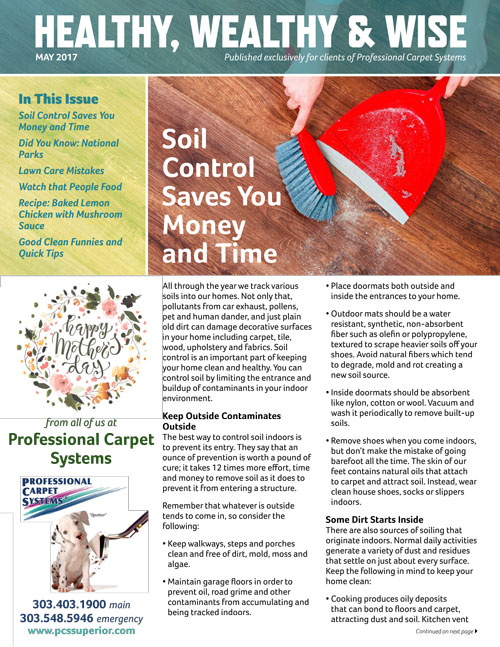This is our May 2017 client newsletter.

Soil Control Saves You Money and Time
All through the year we track various soils into our homes. Not only that, pollutants from car exhaust, pollens, pet and human dander, and just plain old dirt can damage decorative surfaces in your home including carpet, tile, wood, upholstery and fabrics. Soil control is an important part of keeping your home clean and healthy. You can control soil by limiting the entrance and buildup of contaminants in your indoor environment.
Keep Outside Contaminates Outside
The best way to control soil indoors is to prevent its entry. They say that an ounce of prevention is worth a pound of cure; it takes 12 times more effort, time and money to remove soil as it does to prevent it from entering a structure.
Remember that whatever is outside tends to come in, so consider the following:
• Keep walkways, steps and porches clean and free of dirt, mold, moss and algae.
• Maintain garage floors in order to prevent oil, road grime and other contaminants from accumulating and being tracked indoors.
• Place doormats both outside and inside the entrances to your home.
• Outdoor mats should be a water resistant, synthetic, non-absorbent fiber such as olefin or polypropylene, textured to scrape heavier soils off your shoes. Avoid natural fibers which tend to degrade, mold and rot creating a new soil source.
• Inside doormats should be absorbent like nylon, cotton or wool. Vacuum and wash it periodically to remove built-up soils.
• Remove shoes when you come indoors, but don’t make the mistake of going barefoot all the time.
Some Dirt Starts Inside
There are also sources of soiling that originate indoors. Normal daily activities generate a variety of dust and residues that settle on just about every surface. Keep the following in mind to keep your home clean:
• Cooking produces oily deposits that can bond to floors and carpet, attracting dust and soil. Kitchen vent hoods remove odors and filter out oils and moisture too.
• Humans shed millions of skin cells every day. The more people and pets there are in the home, the more dead skin, body oils, perspiration and debris accumulate in carpets, furnishings and air ducts.
• Gas and oil-fired heating systems also produce carbon pollution. Even candles can contribute to soiling of carpets and furnishings.
• Use vent fans when showering. Bathroom vent fans exhaust excess moisture outside and help prevent condensation on surfaces. Dust sticks to moisture and creates a residual film on surfaces. This film can become a breeding ground for bacteria and surface mold.
• Vacuuming is the most effective way to maintain your carpets. 74-79% of soil in carpet is dry, particulate soil that can be removed by vacuuming. You should also vacuum your upholstered furniture, drapery and blinds for the same reasons.
• When you dust your furniture, do so gently, preferably with a duster attachment on your vacuum cleaner. If you use a duster, go slow and allow dust to settle for an hour or so and vacuum the floor last.
Annual professional cleaning is recommended in most homes. Busy homes with children and pets require cleaning twice a year or more depending on lifestyle. Don’t wait until your carpets, rugs and upholstery look dirty to have them cleaned; by the time fibers have reached a visibly soiled state they are already damaged.
Unfortunately, cleaning cannot repair the damage caused by excessive soiling.
Call Professional Carpet Systems to schedule your next cleaning or for more expert advice.
